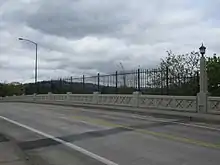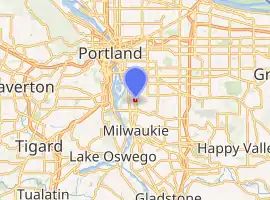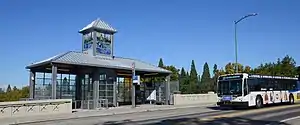Bybee Bridge
The Bybee Bridge is a bridge over McLoughlin Boulevard (Oregon Route 99E) in southeast Portland, Oregon connecting the Eastmoreland and Sellwood neighborhoods.[1] The bridge is named after James Francis Bybee.[1]
Bybee Bridge | |
|---|---|
 Bybee Bridge in 2012 | |
| Coordinates | 45°28′28″N 122°38′24″W |
| Crosses | |
| Locale | Portland, Oregon, U.S. |
| Maintained by | Oregon Department of Transportation |
| Location | |

| |
History
_-_05.JPG.webp)
The original Bybee Bridge consisted of three different structures built between 1911 and 1943.[2][3]
In the early 2000s, structural analysis determined the bridge did not provide adequate clearance for trucks driving below, concrete girders were damaged from collisions, and suitable bike lines and sidewalks were not available.[2][3]
In 2004 the bridge was partially rebuilt by Capital Concrete Construction Inc.,[3] closing in February and re-opening in November ahead of schedule. 80 percent of the $3–4 million renovation project came from federal funds; 10 percent each was paid by the city of Portland and the Oregon Department of Transportation.[1][2]
By April 2005 cracks had already started to appear in the concrete. According to the supervising bridge engineer, the cracks "did not pose any threat to the integrity of the bridge."[1]

During construction of the Southeast Bybee Boulevard MAX Station on the MAX Orange Line, the bridge was widened and elevators and bus pullouts were installed. The station is an island platform located underneath the overpass, with a cupola on the bridge serving as an entrance.[4]
Bybee Bridge Bioswale
According to The Conservation Registry the Bybee Bridge Bioswale, located at the northwest side of the bridge to treat stormwater,[5] was also completed in November 2004.[6] The bioswale contains mostly mowed grass which drains water from the bridge to Crystral Springs. A September 2011 survey of the project showed low invasive species activity but noted the presence of blackberry, morning glory and other weeds. Native plants such as alder, ash, cattail, cottonwood, Douglas-fir, rushes and sedges were also present.[7][8]
See also
- Bybee–Howell House, the Sauvie Island house built by James Francis Bybee
- Transportation in Portland, Oregon
References
- Sanders, Jacob Quinn (April 12, 2005). "New Bybee bridge shows cracks". Portland Tribune. Portland, Oregon: Pamplin Media Group. pp. 1–2. Retrieved May 19, 2012.
- Hamilton, Don (May 18, 2004). "A sleeker, more modern Bybee Bridge". Portland Tribune. Portland, Oregon: Pamplin Media Group. Retrieved May 20, 2012.
- "Bybee Bridge to close". Portland Business Journal. Portland, Oregon: Advance Publications. January 20, 2012. Retrieved May 20, 2012.
- "SE Bybee Boulevard station area". Portland–Milwaukie Light Rail Project. TriMet. Retrieved 29 December 2014.
- "Bybee Bioswale" (PDF). The Conservation Registry. Retrieved June 22, 2012.
- "Bybee Bridge Bioswale". The Conservation Registry. January 6, 2012. Retrieved June 22, 2012.
- "2011 Survey Results" (PDF). The Conservation Registry. 2011. Retrieved June 22, 2012.
- "Bybee Bridge Bioswale Photos" (PDF). The Conservation Registry. September 29, 2011. Retrieved June 22, 2012.
External links
| Wikimedia Commons has media related to Bybee Bridge. |
- Image: Bybee Bridge Bioswale, The Conservation Registry